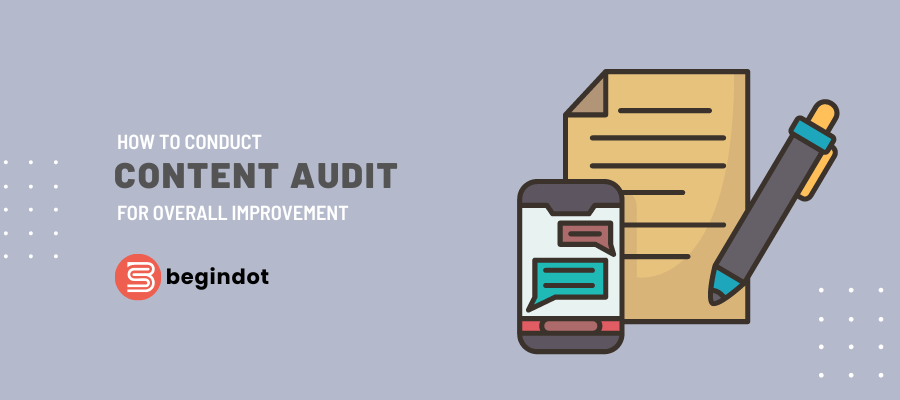For any content marketing strategy to be effective, you need to identify gaps in your existing content and make data-driven decisions to improve your content. And to identify the flaws in your content strategy, you need to conduct a thorough content audit.
There are multiple content audit tools that you can use to get a comprehensive idea about the overall quality of your content and how it is optimized for search engines.
You can use Semrush for content audit, it will give you an in-depth idea about the issues that your site might have to avoid traffic drop.
In this article, we will take you through the steps to conduct a successful content audit. But first, let’s understand the benefits of it.
What Are The Benefits of the Content Audit?
A content audit can benefit your content marketing strategy in multiple ways:

Improved content performance:
A content audit will allow you to evaluate the performance of your existing content to identify the ones that your audiences are resonating with. This will help you make decisions based on data, about how to improve your content, resulting in higher traffic, engagement, and conversions.
Increased efficiency:
By identifying low-performing content, you can focus your efforts on the types of content that are performing and driving traffic. This allows more efficient use of your resources and reduces any wasted time creating non-performing content.
Supports SEO efforts:
Content audit will help you identify opportunities to improve your SEO efforts. Some of your older content may no longer rank well in search engines due to changes in SEO best practices. With a content audit, you can identify, update or repurpose this content to improve its SEO and drive more organic traffic to your site.
Effective social media marketing:
A content audit will also help you improve your content’s performance on social media. Certain types of content are more popular on certain social media platforms than others. With the help of content audit, you can find the right content type and focus on creating it to drive more engagement.
Identify content gaps:
Identify the gaps in your current content strategy to create new content to fill these gaps. It will ensure that you’re not missing out on any opportunities. It will also help you create better content with a better understanding of your audience’s needs.
Cost savings:
By identifying low-performing and focusing on creating high-quality content that drives results, you can avoid wasting resources on pieces that aren’t likely to be successful.
How to conduct a successful content audit?
Step 1: Set Goals and Objectives
Start your content audit with a clear idea of what you want you want to achieve. The most common goals of a content audit include:
- Identify high-performing content to repurpose or update
- Identify low-performing content that needs to be removed or improved
- Identify gaps in your current content strategy
- Identify opportunities to improve your content SEO efforts
- Identify opportunities to improve your performance on social media
Once you have established some clear goals and objectives, use them to guide the rest of your audit.
Step 2: Make a List of Your Content
In this step, you will make a list of all of the content that you want to include in your audit. You can include blog posts, articles, videos, images, infographics, and other types of content. Add the list of your content in a spreadsheet or a content management system (CMS) for easy reference.
Step 3: Organize Your Content
Once you have the complete list of content in one place, organize it in a way that makes it easy to analyze. You can organize the content by – topic or theme, format (e.g. blog post, article, video, image), etc.
You can use this information to help you identify patterns and trends in your content.
Step 4: Analyze Your Content
Analyze your content using the following metrics:
- Traffic: How much traffic each piece of content is getting
- Engagement: How much engagement (e.g. comments, shares, likes) each piece of content is getting
- Conversion: How many conversions (e.g. sign-ups, sales) each piece of content is driving
- SEO: How well each piece of content is performing in search engines
You can gather this data using tools like Google Analytics, Google Search Console, and social media analytics.
Step 5: Identify Opportunities for Improvement
Once you’ve analyzed your content, use the data you’ve to identify opportunities based on the goals set in the first step. Make a list of changes you need to make to your content.
Step 6: Implement the changes
Now it’s time to make all necessary changes based on the opportunities you’ve identified. It would be any or all of the following:
- Repurposing or updating high-performing content
- Removing or improving low-performing content
- Creating new content to fill gaps in your coverage
- Optimizing your content for SEO
- Optimizing your content for social media
It’s important to keep in mind that a content audit isn’t a one-time process. It’s something you should do regularly to ensure that your content is effective and up-to-date.
Conducting a content audit can be a lot of work, but it’s well worth the effort. By taking the time to analyze your content and identify opportunities for improvement, you’ll be able to make data-driven decisions that will help you achieve your goals and objectives. Here are a few additional tips to keep in mind as you conduct your audit:
- Be thorough: Include all of your content in your audit, not just your most recent or most popular pieces.
- Be objective: It can be easy to get attached to certain pieces of content, but it’s important to be objective when analyzing their performance. If a piece of content isn’t performing well, it may need to be removed or improved.
- Be consistent: Make sure you use the same metrics and analysis techniques for each piece of content to ensure that you’re comparing apples to apples.
- Involve others: Involve different people from your team or stakeholders to have different perspectives, this will ensure more accurate and efficient results.
- Keep your audience in mind: Your audience’s preferences and behavior are essential for your content’s success, therefore it should be always kept in mind when evaluating your content.
Overall, a content audit is essential for improving your content and overall viewership. If you find the process difficult, you can seek help from a content marketing expert to get it done.
By taking the time to evaluate your existing content and identify opportunities for improvement, you’ll be able to create more effective content that resonates with your audience and helps you achieve your goals and objectives.









